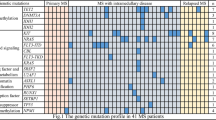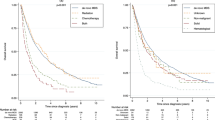Abstract
As diagnosing therapy-related myeloid neoplasms (t-MN) is often challenging, we reviewed clinicopathological features of t-MN patients. Medical records of 138 patients, diagnosed with t-MN between 1995 and 2017, were reviewed. Of 138 patients, 80 had t-MDS, 53 t-AML, and 5 t-MDS/MPN (age, 22–88 years; median 64 years; male/female ratio, 0.8). The median latency time was 6 years and 5 months. Of 115 patients, 56 patients received cytotoxic-/radiotherapy for a solid tumor, 56 for hematological malignancy, and 3 for an auto-immune disorder, respectively. Another 21 patients had a combination of 2 disorders. Moreover, 2 patients had 3 previous malignancies. Breast cancer was the most prevalent tumor, followed by low-grade B non-Hodgkin lymphoma. Immunophenotyping and immunohistochemistry showed aberrant expression of B-, T-, or NK-cell markers in 21% and 6%, respectively. In 90% of the patients, dysplasia in ≥ 1 lineage was found. KMT2A fusion gene transcripts were seen in 5%. Cytogenetic analysis showed complex karyotypes (31%) and chromosome 5 and/or 7 abnormalities (40%). Almost 82% of the patients died and the median overall survival was about 1 year. Our study confirms that previous therapy for breast cancer is the most important cause of t-MN. KMT2A fusion genes are prevalent and complex karyotypes and/or chromosomes 5 and/or 7 abnormalities are common.



Similar content being viewed by others
References
Vardiman JW, Arber DA, Brunning RD, Larson RA, Matutes E, Baumann I et al (2017) Therapy-related myeloid neoplasms. In: Swerdlow SH, Campo E, Harris NL, Jaffe ES, Pileri SA, Stein H et al (eds) WHO classification of tumours of haematopoietic and lymphoid tissues. International Agency of Research on Cancer (IARC), Lyon, p 153–155
Bueso-Ramos CE, Kanagal-Shamanna R, Routbort MJ, Hanson CA (2015) Therapy-related myeloid neoplasms. Am J Clin Pathol 144:207–218
McNerney ME, Godley LA, Le Beau MM (2017) Therapy-related myeloid neoplasms: when genetics and environment collide. Nat Rev Cancer 17(9):513–527
Fianchi L, Pagano L, Piciocchi A, Candoni A, Gaidano G, Breccia M, Criscuolo M, Specchia G, Maria Pogliani E, Maurillo L, Aloe-Spiriti MA, Mecucci C, Niscola P, Rossetti E, Mansueto G, Rondoni M, Fozza C, Invernizzi R, Spadea A, Fenu S, Buda G, Gobbi M, Fabiani E, Sica S, Hohaus S, Leone G, Voso MT (2015) Characteristics and outcome of therapy-related myeloid neoplasms: report from the Italian network on secondary leukemias. Am J Hematol 90(5):E80–E85
Chen Y, Estrov Z, Pierce S, Qiao W, Borthakur G, Ravandi F, Kadia T, Brandt M, O’Brien S, Jabbour E, Garcia-Manero G, Cortes J, Beran M (2015) Myeloid neoplasms after breast cancer: “therapy-related” not an independent poor prognostic factor. Leuk Lymphoma 56:1012–1019
Kröger N, Brand R, Van Biezen A, Zander A, Dierlamm J, Niederwieser D et al (2009) Risk factors for therapy-related myelodysplastic syndrome and acute myeloid leukemia treated with allogeneic stem cell transplantation. Haematologica 94(4):542–549
Pemmaraju N, Shah D, Kantarjian H, Orlowski RZ, Nogueras González GM, Baladandayuthapani V, Jain N, Wagner V, Garcia-Manero G, Shah J, Ravandi F, Pierce S, Takahashi K, Daver N, Nazha A, Verstovsek S, Jabbour E, de Lima M, Champlin R, Cortes J, Qazilbash MH (2015) Characteristics and outcomes of patients with multiple myeloma who develop therapy-related myelodysplastic syndrome, chronic myelomonocytic leukemia, or acute myeloid leukemia. Clin Lymphoma, Myeloma Leuk 15(2):110–114
Shih AH, Chung SS, Dolezal EK, Zhang S-J, Abdel-Wahab OI, Park CY, Nimer SD, Levine RL, Klimek VM (2013) Mutational analysis of therapy-related myelodysplastic syndromes and acute myelogenous leukemia. Haematologica 98(6):908–912
Churpek JE, Marquez R, Neistadt B, Claussen K, Lee MK, Churpek MM, Huo D, Weiner H, Bannerjee M, Godley LA, le Beau MM, Pritchard CC, Walsh T, King MC, Olopade OI, Larson RA (2016) Inherited mutations in cancer susceptibility genes are common among survivors of breast cancer who develop therapy-related leukemia. Cancer 122(2):304–311
Morton LM, Dores GM, Tucker MA, Kim CJ, Onel K, Gilbert ES, Fraumeni JF, Curtis RE (2013) Evolving risk of therapy-related acute myeloid leukemia following cancer chemotherapy among adults in the United States, 1975-2008. Blood 121(15):2996–3004
Smith SM, Le Beau MM, Huo D, Karrison T, Sobecks RM, Anastasi J et al (2003) Clinical-cytogenetic associations in 306 patients with therapy-related myelodysplasia and myeloid leukemia: the University of Chicago series. Blood 102(1):43–52
Radivoyevitch T, Sachs RK, Gale RP, Molenaar RJ, Brenner DJ, Hill BT, Kalaycio ME, Carraway HE, Mukherjee S, Sekeres MA, Maciejewski JP (2016) Defining AML and MDS second cancer risk dynamics after diagnoses of first cancers treated or not with radiation. Leukemia 30(2):285–294
Henau K, Francart J, Silversmit G, Vandendael T, Pieters G, Xicluna J et al (2015) Cancer burden in Belgium. Belgian Cancer Registry, Brussels, p 135–146
Churpek JE, Larson RA (2013) The evolving challenge of therapy-related myeloid neoplasms. Best Pract Res Clin Haematol 26(4):309–317
Sill H, Olipitz W, Zebisch A, Schulz E, Wölfler A (2011) Therapy-related myeloid neoplasms: pathobiology and clinical characteristics. Br J Pharmacol 162(4):792–805
Pedersen-Bjergaard J, Andersen MK, Andersen MT, Christiansen DH (2008) Genetics of therapy-related myelodysplasia and acute myeloid leukemia. Leukemia 22(2):240–248
Wong TN, Ramsingh G, Young AL, Miller CA, Touma W, Welch JS, Lamprecht TL, Shen D, Hundal J, Fulton RS, Heath S, Baty JD, Klco JM, Ding L, Mardis ER, Westervelt P, DiPersio JF, Walter MJ, Graubert TA, Ley TJ, Druley TE, Link DC, Wilson RK (2015) Role of TP53 mutations in the origin and evolution of therapy-related acute myeloid leukaemia. Nature 518(7540):552–555
Kayser S, Döhner K, Krauter J, Köhne CH, Horst HA, Held G et al (2011) Impact of therapy-related acute myeloid leukaemia (AML) on outcome in 2853 adult patients with newly diagnosed AML. Blood 117(7):2137–2145
Kern W (2004) Prognosis in therapy-related acute myeloid leukemia and impact of karyotype. J Clin Oncol 22(12):2510–2511
Author information
Authors and Affiliations
Corresponding author
Ethics declarations
Conflict of interest
The authors declare that they have no conflict of interest.
Electronic supplementary material
ESM 1
(DOCX 18 kb)
Rights and permissions
About this article
Cite this article
Claerhout, H., Lierman, E., Michaux, L. et al. A monocentric retrospective study of 138 therapy-related myeloid neoplasms. Ann Hematol 97, 2319–2324 (2018). https://doi.org/10.1007/s00277-018-3462-y
Received:
Accepted:
Published:
Issue Date:
DOI: https://doi.org/10.1007/s00277-018-3462-y




